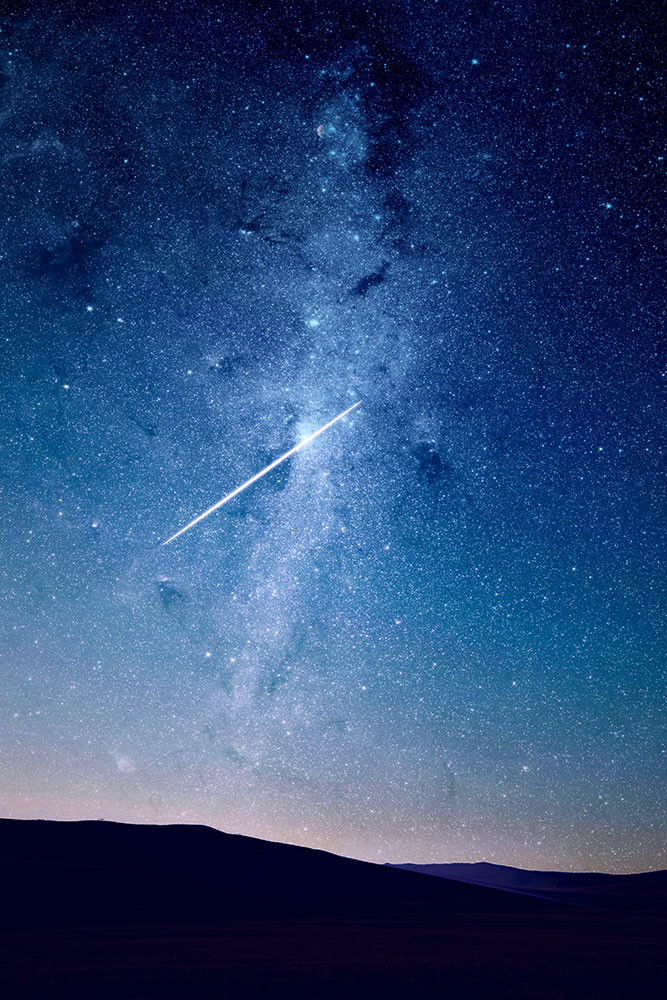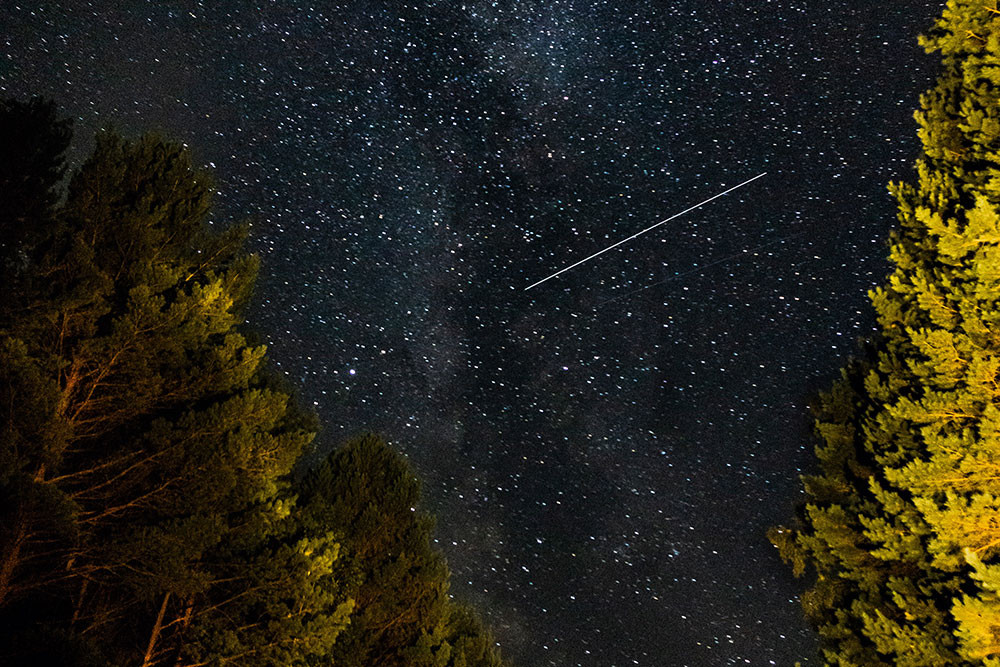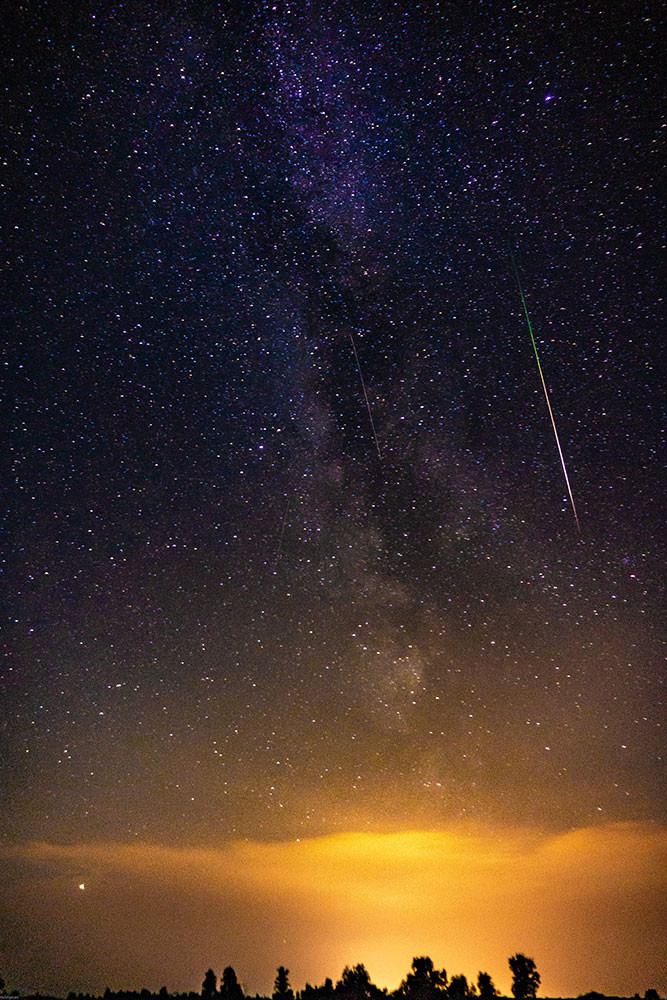Meteor showers
Showers of Light
The Greeks and Romans thought meteors’ dramatic light shows in the night sky were portents of future events. For us, gazing up into a clear night sky isn’t just a view into the peace and tranquillity of the nighttime; it’s a chance to glimpse traces of the origin of time itself…
Find out when you could be catching glimpses of meteor showers in 2022 across the UK and the Lake District skies…

The grains of dust and hulks of rock left over from the formation of the planets in our solar system are constantly moving through space. When small chunks of rock and dust enter the atmosphere, at up to 70km per second, friction with the thin air of our skies creates a bright, fleeting glow as the rock burns and disappears. If you witness this trail of light you have seen a meteor. The bright appearance of these rocks – moving across the black sky – led to the meteor misnomer ‘shooting star’.
If you witness this trail of light you have seen a meteor. The bright appearance of these rocks – moving across the black sky – led to the meteor misnomer ‘shooting star’.
In clear skies you can see meteors at any time, but your best chance to spot them is during the meteor ‘showers’ that occur when the Earth passes through the dust left behind by a comet (frozen chunks of dust and gas – remnants of the Big Bang), or in some cases, asteroids (primarily formed of rock), that orbit the sun.

So, which meteor showers might you see in the dark skies above the Lake District in 2022? We’ve chosen some of the most active meteor showers to keep an eye out for in the coming months:
Eta Aquariids Meteor Shower, 19 April to 28 May
Made up of debris left in the wake of Halley’s Comet, the meteors of the Eta Aquariids shower often produce long streaks of light. Keep your eyes set on the sky, as these dazzling trains can linger for several seconds. While not as abundant as some meteor showers, Eta Aquariids is still well worth a watch and makes for a starry opener to alfresco season.
Meteor Shower, 12 July to 23 August
Up to 150 meteors per hour will streak across the sky, peaking on 12 August with a waxing moon, as the Earth collides with matter left from the Swift-Tuttle comet. Found mostly around their namesake, star Perseus the Hero. The most significantly active meteor shower every year, low moonlight and a balmy summer evening (fingers crossed!) make it a good one for the diary.
Meteor Shower, 6 October to 10 October
In the wake of the Comet 21/P Giacobini-Zimmer, your best chance of glimpsing the Draconid shower is on 8 October. Unlike other meteor showers that are better viewed in the early hours, the Draconids are best viewed on a clear unobstructed horizon in the evening – so there’s no need to set your alarm clock for some unholy hour in the middle of the night.
Sometimes named the Giacobinids, after the scientist who discovered Comet 21-P, Michel Giacobini, if you trace the meteors they seem to originate from a point in the constellation of Draco from where they take their common name. The constellation is highest in the sky at nightfall.
Orionid Meteor Shower, 2 October to 7 November
The fast-moving, fine trains of light from Orionid are associated with the famous Comet Halley. The meteors’ path seems to originate from a point in the Orion constellation, which gives the meteor shower its name.
Visible around the world, the Orionid meteor shower is made up of pieces of Comet 1P/Halley. While Comet Halley only passes earth every 75-76 years, the tiny debris falling from the comet as it orbits the sun enters our earth’s atmosphere each year. An early start could be rewarded with as many as 20 spectacular meteors per hour.
Seeking out a truly dark sky means the chance to see close to 100 meteors per hour, with the meteors of Geminid burning in several colours due to the trace metals found in the rocks entering the atmosphere.
Geminid meteor shower, 4 December to 20 December
The Geminid is a reliable and remarkable meteor shower. Seeking out a truly dark sky means the chance to see close to 100 meteors per hour, with the meteors of Geminid burning in several colours due to the trace metals found in the rocks entering the atmosphere.
Locating the bright star Castor in the constellation Gemini will show the point at which the meteor shower begins, giving the meteors – which are visible before midnight – their name.
Geminid is one of two major meteor showers that do not originate from comets. The space rock and dust originate from the asteroid 3200 Phaeton.

Night swims
Advocates of dark skies, we want our guests to get outdoors and enjoy the night sky, even from the lake. Colin Hill, our resident open water swimming expert takes monthly full moon swims from our hotel jetty along the shores of Ullswater, as well as stargazing swims when the moon is less full and you can see more in the sky. Book online and join one during your stay.
For a full list of the best places to stargaze and watch the meteor showers read our blog stargazing in the Lake District
Find out more about how to prepare for star or meteor gazing.
Read the rmg’s meteor shower guide for more dates in 2022.